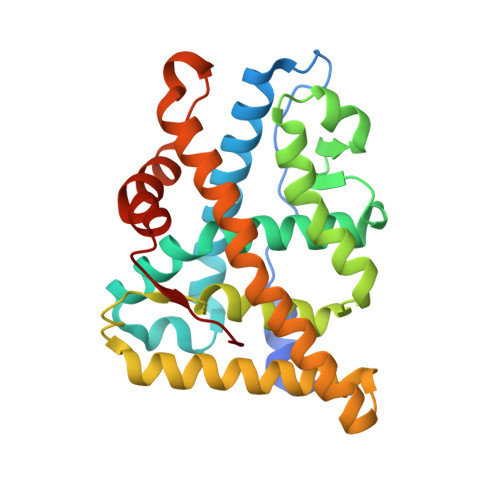X-ray structures of progesterone receptor ligand binding domain in its agonist state reveal differing mechanisms for mixed profiles of 11 beta-substituted steroids.
Lusher, S.J., Raaijmakers, H.C., Vu-Pham, D., Kazemier, B., Bosch, R., McGuire, R., Azevedo, R., Hamersma, H., Dechering, K., Oubrie, A., van Duin, M., de Vlieg, J.(2012) J Biological Chem 287: 20333-20343
- PubMed: 22535964
- DOI: https://doi.org/10.1074/jbc.M111.308403
- Primary Citation of Related Structures:
4A2J, 4APU - PubMed Abstract:
We present here the x-ray structures of the progesterone receptor (PR) in complex with two mixed profile PR modulators whose functional activity results from two differing molecular mechanisms. The structure of Asoprisnil bound to the agonist state of PR demonstrates the contribution of the ligand to increasing stability of the agonist conformation of helix-12 via a specific hydrogen-bond network including Glu(723). This interaction is absent when the full antagonist, RU486, binds to PR. Combined with a previously reported structure of Asoprisnil bound to the antagonist state of the receptor, this structure extends our understanding of the complex molecular interactions underlying the mixed agonist/antagonist profile of the compound. In addition, we present the structure of PR in its agonist conformation bound to the mixed profile compound Org3H whose reduced antagonistic activity and increased agonistic activity compared with reference antagonists is due to an induced fit around Trp(755), resulting in a decreased steric clash with Met(909) but inducing a new internal clash with Val(912) in helix-12. This structure also explains the previously published observation that 16α attachments to RU486 analogs induce mixed profiles by altering the binding of 11β substituents. Together these structures further our understanding of the steric and electrostatic factors that contribute to the function of steroid receptor modulators, providing valuable insight for future compound design.
- Departments of Molecular Design and Informatics, MSD, P. O. Box 20, 5340 BH, Oss, The Netherlands.s.lusher@esciencecenter.nl
Organizational Affiliation:


















